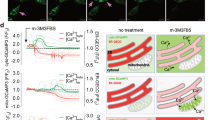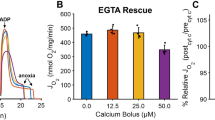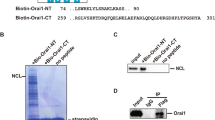Abstract
Both calcium ionophore A23187 and endoplasmic reticulum Ca2+ - ATPase inhibitor thapsigargin (Tg) could increase intracellular free calcium concentration and induce apoptosis in some cell lines. In the present study, we found that HL-60 cells treated with A23187 (1 μg/ml) for 4 h or with Tg (0.5 μg/ml) for 2 h showed typical characteristics of apoptosis. Pretreatment with nontoxic concentration of cyclosporin A (CsA) (1 μg/ml) could block these effects. Flow cytometric analysis of intracellular Ca2+ after staining with fluo-3 AM showed that CsA did not prevent the increase of intracellular calcium induced by A23187 or Tg, but it could maintain the high level of intracellular Ca2+ for a long time. These results suggest that CsA may prevent calcium-induced apoptosis by blocking the transportation of Ca2+ in HL-60 cells.
Similar content being viewed by others
Introduction
Cyclosporin A (CsA), an immunosuppressive agent, could selectively inhibit T lymphocyte activation and proliferation, and could also prevent activation-driven apoptosis1. Recently, evidences that CsA could block apoptosis were found in other cell lines such as T-cell hybridomas and B-cell lines1, 2.
Ca2+ plays an important role in apoptosis. Many types of apoptosis are dependent on Ca2+. In apoptosis of glucocorticoid-treated thymocytes, it has been postulated that activation of Ca2+/Mg2+-dependent endonuclease may be responsible for internucleosomal DNA fragmentation. In that system, elevation of intracellular Ca2+ concentration appeared to serve as an early signal for initiation of apoptosis3. In other cell lines, increasing intracellular Ca2+ with calcium ionophore or Tg also leads to apoptosis4, 5.
In this paper, questions whether A23187 or Tg could induce apoptosis in HL-60 cells, and whether the induced apoptosis could be inhibited by CsA were investigated. Then, the possible correlation between calcium-transportation and CsA was examined, in order to find out the way by which CsA blocks apoptosis.
Materials and Methods
Materials
Cyclosporin A was purchased from Sino-Amercian Medicine of East China Ltd. Propidium iodide, A23187, thapsigargin and Fluo-3 AM were purchased from Sigma. Hoechst 33342 was purchased from Molecular Probe.
Cell culture and drug dosage-reaction curves
HL-60 cells were grown at 37°C in RPMI 1640 medium (GIBCO) containing 10% heat-inactivated fetal bovine serum in an atmosphere with 5% CO2. Cells in log phase were planted to 24 well plate at the density of 20×104 cells/ml, and various concentration of CsA was added to the medium. Cell numbers were counted at 12, 24, 48 h respectively, and cell viability was assessed as follows.
Drug treatment and cell viability assessment
Exponentially growing HL-60 cells were exposed to drugs for the time as indicated. Cells after drug treatment were stained with Hoechst 33342 (10 μM) and propidium iodide (50 μg/ml) for 20 min, then washed with PBS and resuspended in PBS. Morphological and quantitative analysis of apoptosis was performed with fluorescence microscopy (Olympus) as described6.
DNA extraction and electrophoresis
The pattern of DNA cleavage was analyzed by agrose gel electrophoresis as described7. Briefly, cells (1×106) were lysed with 200 μl lysis buffer (10 mM EDTA; 50 mM Tris-HCL, pH 8.0; 0.5%(W/v) N-lauroyl sarcosine; 0.5 mg/ml proteinase K) and incubated for 1 h at 50°C. Then RNase A was added to a final concentration of 0.5 mg/ml, and incubated for another hour at 50°C. After phenol extraction and ethanol precipitation, samples of 1.5 μg in each lane were subjected to electrophoresis on a 1.2 % agrose gel. DNA was stained with ethidium bromide.
Flow cytometry analysis
Flow cytometric analysis was also performed to identify apoptotic cells as descried6. Briefly, cells were fixed in 70% ethanol overnight at 4°C, incubated in PBS containing 50 μg/m] RNase A at 37°C for 1 h, stained with 65 μg/ml PI for 1 h at 4°C, and then analyzed by the use of a FACS 420 flow cytometer.
Determination of intracellular Ca2+ concentration
Ceils were loaded with 10 μM Fluo-3 AM for at least 30 min at 37°C, washed by centrifugation for 3 min at 800 ×g and resuspended in RPMI 1640 medium (37°C)8. Intracellular Ca2+ concentration was measured by flow cytometry.
Results
Inhibitory effect of CsA on the HL-60 cell proliferation
As shown in Fig 1, the maximum concentration of CsA that did not obviously affect the growth of HL-60 cells was 3 μg/ml. Combined staining with PI and Hoechst 33342 revealed that cells treated with 0.5∼3 μg/ml CsA did not undergo apoptosis or necrosis (< 5%) within 24 h.
Apoptosis of HL-60 cells induced by A23187 or Tg
Exposure of HL-60 cells to A23187 (1 μg/ml) for 4 h or Tg (0.5 μg/ml) for 2 h led to apoptosis (Fig 2). Combined staining with Hoechst 33342 and PI showed condensed nuclei in a large number of cells (Fig 3B, 3C), and the necrotic cells (PI positive) was below 5% (data not shown). Agarose gel electrophoresis of DNA revealed a “ladder” pattern(Fig 4 lane 2, 4). Apoptotic DNA peak could be seen in DNA histogram after flow cytometric analysis (Fig 5A).
Percent of apoptotic cells in HL-60 cells preincubated with or without CsA for 4h, then treated with A23187 or Tg for various time.
A. ○, A23187 (l μg/ml) only; •, CsA(3 μg/ml) + A23187(l μg/ml); ×, CsA(1 μg/ml) + A23187(1 μg/ml); □, CsA(0.5 μg/ml) + A23187 (1 μg/ml).
B. ○, Tg(0.5 μg/ml) only; •, CsA(3 μg/ml) + Tg (0.5 μg/ml); ×, CsA(1 μg/ml) + Tg (0.5 μg/ml); □, CsA (0.5 μg/ml) + Tg(0.5 μg/ml).
Morphological appearance of HL-60 cells stained with Hoechst 33342 and observed under fluorescence microscope. (A) and (A′), control. (B), A23187 1 μg/ml for 4 h. (B′), CsA 1 μg/ml for 4 h, then A23187 1 μg/ml for 4 h. (C), Tg 0.5 μg/ml for 2 h. (C′), CsA 1 μg/ml for 4 h, then Tg 0.5 μg/ml for 2 h. × 400.
Flow cytometric studies of propidium iodide-stained HL-60 cells. Cells were pretreated with (B) or without (A) CsA 1 μg/ml for 4 h, then treated with A23187 1 μg/ml for 4 h (b, b′) or Tg 0.5 μg/ml for 2 h (c, c′). (a) and (a′) control. Apoptotic cells can be recognized by their diminished stainability with propidium iodide and appearance of a “sub-Gl” peak.
CsA blocks apoptosis induced A23187 or Tg
Pretreatment of HL-60 cells with nontoxic CsA (0.5∼3 μg/ml) for 4 h, then added A23187 to a final concentration of 1 μg/ml or Tg to 0.5 μg/ml. The amount of apoptotic cells were greatly decreased (Fig 2). When appropriate concentration of CsA (1 μg/ml) was used for further study, we could see those characteristics of apoptosis induced by A23187 or Tg disappeared (Fig 3B′, 3C′; Fig 4 lane 3, 5; Fig 5B).
Alteration of intracellu]ar Ca2+ level
Measurement of intracellular Ca2+ showed that A23187 increased the intracellular Ca2+, but the high level of intracellular Ca2+ decreased quickly (Fig 6A). CsA did not prevent the increase of intracellular Ca2+ induced by A23187, but it could maintain the high level of intracellular Ca2+ for much longer time (Fig 6B). However, CsA alone did not alter the intracellular Ca2+ concentration (Fig 6C). The same result was got with Tg (Fig 7).
Intracellular Ca2+ levels in HL-60 cells. Histograms (log scale) of fluorescence intensity after staining with fluo-3 AM. Cells were preincubateed with (B) or without (A) CsA 1 μg/ml for 4 h, then treated with A23187 1 μg/ml for various time. (1) Control, (2) 10 min, (3) 30 min, (4) 60 min. (C) control, CsA 1 μg/ml for 4 h.
Discussion
Our results showed that both A23187 and Tg could induce apoptosis of HL-60 cells, which indicated that Ca2+ is an important factor during apoptosis of HL-60 cells. But high level of intracellular Ca2+ was not required to maintain for long time for the induction of apoptosis. So it seems that Ca2+ only initiates apoptosis, and other later events induced by Ca2+ such as activation of Ca2+/Mg2+-dependent endonuclease etc. finally lead to apoptosis, as observed in other system3.
Studies on apoptosis VP-16 treated HL-60 cells indicated that no significant increase of intracellular Ca2+ was observed. Pretreatment with EGTA failed to prevent apoptosis induced by VP-16. On the contrary, BAPTA-AM, a chelator of intracellular Ca2+, could inhibit it. These evidences suggested that in HL-60 cells, apoptosis may depend not on extracellular Ca2+, but on intracellular Ca2+. So it may be the redistribution of intracellular Ca2+ that plays an important role in apoptosis of HL-60 cells, especially the elevation in nuclear Ca2+ due to Ca2+ influx from cytosol fraction9.
Our results showed that the high level of intracellular Ca2+ induced by A23187 or Tg maintained for a short time, and decreased quickly. Yet the increase is sufficent to initiate apoptosis. The reason may be that high level of intracellular Ca2+ activated Ca2+ - ATPase located in the membrane of intracellular Ca2+ pool and nuclear evelope10, and thus induced the redistribution of intracellular Ca2+, especially the transportation of Ca2+ into nucleus which finally leads to apoptosis. At the same time, Ca2+ - ATPase on plasma membrane was also activated, which pumped excessive Ca2+ out of the cell.
It is not clear how CsA blocks apoptosis. Since it is a specific inhibitor of protein phosphatase 2B (calcineurin), some people thought that CsA prevents apoptosis by inhibiting the activity of calcineurin11. Recently, CsA was found to affect some other factors involved in apoptosis, such as "tissue" transglutaminase (tTG)12, and transcription factor Nur7713. According to our results, CsA prevented the decrease of intracellular Ca2+, indicating that CsA may inhibit transportation of Ca2+. Since CsA could inhibit the synthesis of ATP14, so the subsequent loss of energy supply may lead to inactivation of Ca2+ -ATPase. As a result, Ca2+ could not be pumped out of the cell, intracellular Ca2+ may then be maintained at a high level. At the same time, Ca2+ could not flux into nucleus, and thus the low intranuclear Ca2+ concentration would be insufficient to activate the endonuclease, and apoptosis couldn't occur. However, this hypothesis needs much further study to verify.
References
Shi YF, Sahai BM, Green DR . Cyclosporin A inhibits activation induced cell death in T cell hybridomas and thymocytes. Nature 1989; 339:625–6.
Nathalie BB, Laurent G, Monique F, Jean PR . The phosphoprotein phosphatase calcineurin controls calcium-dependent apoptosis in B cell lines. Eur J Immunol 1994; 24:325–9.
Orrenius S, Mc Conkey DJ, Bellono G, Nicotera P . Role of Ca2+ in toxic cell killing. Trends pharmacol Sci 1989; 10:281–5.
McConkey D J, Hartzell P, Nicotero P, Orrenius S . Calcium activated DNA fragmentation kills immature thymocytes. FASEB 1989; 3:1843–9.
Yoshiyasu K, Aynmi T . Thapsigargin-induced persistent intracellular calcium pool depletion and apoptosis in human hepatoma cells. Cancer Letter 1994; 79:147–55.
Fang M, Zhang HQ, Xue SB . Induction of apoptosis in HL-60 cells by harringtonine. Chin Sci Bull 1995; 40(11):939–44.
Martin SJ . Protein or RNA synthesis inhibition induces apoptosis of mature human CD4+ T cell blasts. Immunol Lett 1993: 35:125–34.
McConkey D J, Nicotera P, Hartzell P, Bellomo G, Wyllie AH, Orreniou S . Glucocorticoids activate a suicide process in thymocytes through an elevation of cytosolic Ca2+ concentration. Arch Biochem Biophys 1989; 269:365–70.
Akira Y, Takanori U, Rumiko T et al. Role of calcium ion in induction of apoptosis by etoposide in human leukemia HL-60 cells. Biochem Biophys Res Commun 1993; 196(2):927–34.
Nicotera P, Zhivotovsky B, Orrenius S . Nuclear calcium transport and the role of calcium in apoptosis. Cell Calcium 1994; 16:279–88.
Navid AF, Pamela EM, Steven JB, Barbara EB . Correlation of calcineurin phosphatase activity and programmed cell death in murine T cell hybridomas. Eur J Immunol 1992; 22:2513–17.
Amendola A, Lombardi G, Oliverio S, Colizzi v, Piacentini M . HIV gpl20-dependent induction of apoptosis in antigen-specific human T cell clones is characterized by “tissue” transglutaminase expression and prevented by cyclosporin A. FEBS Lett 1994; 339(3):258–64.
Yazdanbakhsh K, Choi JW, Li Y, Lau LF, Choi Y . Cyclosporin A blocks apoptosis by inhibiting the DNA binding activity of the transcription factor Nur77. Proc Natl Acad Sci USA 1995; 92(2):437–41.
Salducci MD, Chauvet-Monges AM, Dussol BM, Berland YF, Crevat MD . Is the beneficial effect of calcium channel blockers against cyclosporin a toxicity related to a restoration of ATP synthesis. Pharmaceutical Res 1995; 12(4):518–22.
Acknowledgements
We thank Drs. Chi Xu Sheng and Pang Da Ban (Institute of Basic Medicine, Academy of Chinese Tradition Medicine) for measuring DNA and calcium with FCM.
Author information
Authors and Affiliations
Additional information
Project supported by the Natural Foundation of China and the Foundation for Ph. D. training from State Education Committee of China
Rights and permissions
About this article
Cite this article
Huang, Q., Fang, M., Zhang, H. et al. Correlation between inhibition of calcium-dependent apoptosis by cyclosporin A and calcium transportation in HL-60 cells. Cell Res 6, 23–30 (1996). https://doi.org/10.1038/cr.1996.3
Received:
Revised:
Accepted:
Issue Date:
DOI: https://doi.org/10.1038/cr.1996.3










